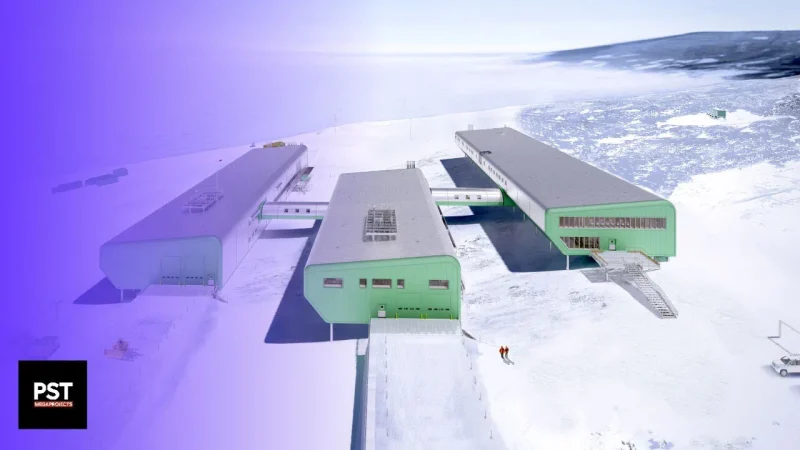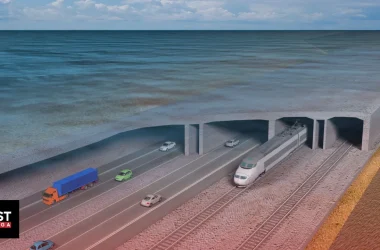Antarctica, the southernmost continent on Earth, is a vast and mysterious land shrouded in ice and harsh conditions. With an area of about 14 million square kilometers, it is the fifth-largest continent, nearly twice the size of Australia. However, despite its enormous size, only a fraction of Antarctica has been explored, leaving much of its secrets locked away in its icy embrace.
However, despite the challenging conditions of extremely low temperature and difficult terrain, Antarctica has captivated the imagination of scientists and explorers for centuries. Expeditions have been undertaken to unravel its mysteries, and research stations have been established to study its unique ecosystems and climate patterns. The Antarctic Treaty System, signed by several nations, ensures that Antarctica is used solely for scientific research and prohibits any military activity or territorial claims.
Navigating Antarctica
Of the total land area, approximately 98% of Antarctica is covered by ice, forming the world’s largest ice sheet known as the Antarctic Ice Sheet. This colossal ice sheet averages around 2,160 meters in thickness and contains about 90% of the world’s ice. The immensity of this ice sheet accounts for the desolate and barren landscape that characterizes much of Antarctica.
The average annual temperature hovers around -49 degrees Celsius (-56 degrees Fahrenheit), making it the coldest place on Earth. In some regions, temperatures can plummet to a bone-chilling -89 degrees Celsius (-128 degrees Fahrenheit) during the winter months. These extreme temperatures, combined with the strong and persistent winds, create a hostile environment where only the most resilient organisms can survive.
The world first set its eyes on the remote continent after World War 2. The main drive was the natural curiosity of the human mind, but this is not to deny the potential benefits the world expected to get by researching the area. After all, who knew what secret sources of energy or wealth could Antarctica hold?
Given that, it’s no surprise that the ambition to explore Antarctica arose in the context of the rivalry between the US and the Soviet Union in the post-war period. Upon getting excluded from an international collaborative research project established by the US with the goal of building research facilities on the continent, the Soviet Union had to embark on its own journey. Surprisingly enough, the Soviet Union would later on achieve greater success than its Western rivals.
The first Soviet expedition was successful in establishing two small research facilities along the coast. The expedition consisted mainly of military trucks and tractors that had been used in World War 2. Soon, however, it was clear that there was no hope for the expedition to progress deeper into Antarctica.
At this point, you might be thinking that the reason is obvious: Antarctica is just so cold that no human can spend a long amount of time there. While this is surely part of what makes the exploration of Antarctica very difficult, there’s a lot more to it than that.
Major Obstacles
First, the main hurdle wasn’t the cold per se, but the terrain. Antarctica has no recognizable landmarks, which made it very difficult for the researchers to draw a map of the area or determine their location, with no help from satellites at the time. Well, you might think, if there weren’t any satellites back then, they at least had compasses, so why not use that? This brings us to the second hurdle: the magnetic field of the Earth.
As one gets closer to either pole, the planet’s magnetic fields get stronger. In Antarctica, it grows so much that it renders compasses useless. Further, it also interferes with radio signals, making radio communication unreliable. The only available method of navigation was looking at the stars.
Finally, the snowy terrain proved impossible for the military trucks with their ordinary tires to traverse. The tractors were more helpful in this regard, as they relied on tracks rather than tires for movement. However, the obvious fatal flaw of tractors is that they don’t provide any form of shelter from the harsh coldness of the environment, so they, too, didn’t allow the researchers to progress far enough.
The need to find a better way of navigating Antarctica was clear, and in 1956 the second expedition began. This time the Soviets were better equipped: they had track-based trucks developed specifically for the purpose of traversing the continent. The expedition established two additional research facilities, this time located deeper into Antarctica, but the Soviets still faced quite a lot of challenges.
Traversing some areas required rising thousands of feet above sea level. At such a high altitude, the air becomes thinner, making it difficult for people to breathe and for truck engines to function properly. Additionally, the extremely low temperature threatened to freeze the vehicle’s fuel. Yes, it was so cold that the liquid fuel was turning into a brick.
The solution was to occasionally light fires under the engines to warm up the fuel inside them. And speaking of engines, it also didn’t help that the researchers needed to fix any issues in the engine by going out in the extreme cold. Finally, there was always the issue of cargo. No fresh drinkable water exists in Antarctica; the continent is basically a gigantic snowy desert. Food is also obviously limited. As a result, the expedition was required to carry tons of cargo, because, in addition to food and water, fuel was also a very limited resource. In fact, fuel alone represented around 70% to 75% of the expedition’s cargo.
All of these challenges finally culminated in the development of the Soviet Union’s ultimate Antarctic conqueror: The Kharkovchanka. Without this amazing vehicle, the Soviet Atlantic expedition could not have succeeded.
The development process was finished in the late 1950s. Considering the technology of the time, there wasn’t really that much of a time gap between the second expedition and the invention of the Kharkovchanka. The engineers had a tight deadline, and the development was rushed, but they managed to eventually get out a good product.
The Kharkovchanka
The vehicle, unsurprisingly, was tracked, but the tracks were notably wider than those of the trucks previously used to traverse the continent. It had a horsepower of over 900, which allowed it to power through whatever obstacles came before it, while carrying over 70 tons of cargo.. It could reach a speed of up to 10 miles per hour. You might think this is too slow and impressive, but try to drive your car up a snowy mountainous terrain before you make up your mind.
So far so good, but this really wasn’t what made the vehicle interesting. The first notable feature of the Kharkovachanka was its engine. The engine was placed inside the vehicle, in order to allow the crew to fix any issue without torturing themselves by going outside. Relatedly, the vehicle was equipped with a central heating unit that kept the crew warm throughout most of the journey. It also featured thick walls covered in synthetic wool on the inside to keep heat from leaking outside.
On top of that, the vehicle contained beds, a small kitchen, and a bathroom. Finally, there was a dome that allowed the crew to look at the stars for navigation. You might be excited after listening to this to ride the Kharkovachanka one day, and enjoy a warm and cozy drive through Antarctica, but don’t jump to conclusions too quickly; riding the vehicle was no simple task.
It’s not true that absolutely all engine repairs could be done from inside the vehicle. Some major issues could only be fixed by going outside. Due to the design and placement of the engine, having to fix the engine from outside was a particularly miserable experience for the vehicle’s crew. Moreover, one could only imagine how irritating it was for the crew to have to deal with the engine noise resounding inside the vehicle all the time, but especially when trying to sleep.
It also didn’t help that engine fumes were leaking into the vehicle, exposing the crew to the threat of carbon monoxide poisoning. The central heating system wasn’t without costs, either. Its existence required the vehicle to consume fuel at the atrocious rate of more than 10 liters per kilometer. This is a hundred times worse than the consumption of the average car.
Despite the flaws, the vehicle was still a major breakthrough, especially when compared to the Snow Cruiser developed by the US, which failed miserably to make progress in Antarctica mostly due to being a tired, rather than tracked, vehicle.
The Future of Exploration
Fast forward to today, the success of this vehicle and the subsequent improved version of it have helped humanity to establish important facilities in Antarctica.
One of the most iconic research facilities in Antarctica is the McMurdo Station, operated by the United States. Located on Ross Island, it serves as a logistical hub and research base for numerous scientific projects. The total cost of constructing and maintaining McMurdo Station over the years has been estimated to be in the hundreds of millions of dollars.
Another prominent research facility is the Amundsen-Scott South Pole Station, situated at the southernmost point of the Earth. It was established to support research in astrophysics, atmospheric sciences, and geophysics. The construction of the South Pole Station started in 1956 and required the transportation of materials and equipment over vast distances.
Due to the extreme conditions and logistical challenges, the construction process was lengthy and complex. The current South Pole Station, which replaced the original one, was completed in 2008 and represents a significant investment of time, resources, and scientific collaboration.
Even though the continent remains underexplored, it’s safe to assume that as time goes on, humanity will continue to find better ways to cope with and tame its harsh environment.
Disclaimer
Please visit and read our disclaimer here.









